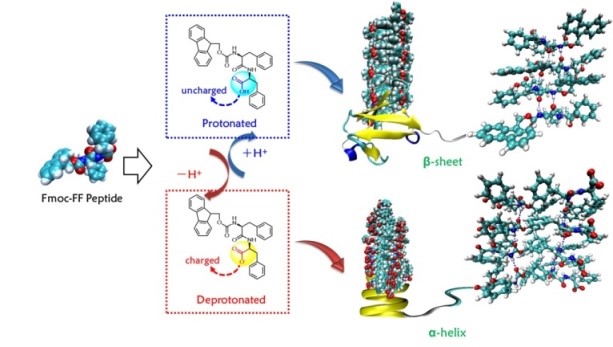Secondary structures such as α-helix and β-sheet are the major structural motifs determining the three-dimensional geometry of proteins. These structures play crucial roles in protein folding pathways that may be very complicated in life system.
The formation of stable β-sheets in amyloid fibrils is related to the occurrence of some neurodegenerative diseases such as Alzheimer or Parkinson. It is believed that an erroneous transition from α-helix to β-sheet structures can give rise to fatal consequences in prion and other amylogenic diseases. Considering these facts, it is speculated that modulating secondary structure transition from β-sheet to α-helix can not only serve as an effective strategy for the therapy of neurological diseases through the inhibition of β-sheet aggregation, but also extend the application of α-helix fibrils in drug delivery and controlled release, three-dimensional (3D) cell culture, tissue engineering and so on.
Actually, many attempts have been made to explore the conversion from β-sheet to α-helix structure in several approaches, as through specific switching elements, with the help of complementary interactions and so on. However, the transformation between β-sheet and α-helix structures seems complicated owing to the lack of flexibility.
Recently, a research team led by Prof. YAN Xuehai at State Key Laboratory of Biochemical Engineering at the Institute of Process Engineering (IPE) of the Chinese Academy of Sciences (CAS) made breakthrough in unraveling the mechanism of secondary structure conversion utilizing a dipeptide Fmoc-FF as a model building block. It is discovered that the transformation from β-sheet to α-helix can be controlled by tuning the charges of the C-terminal domain, thus leading to different supramolecular assemblies. The electrostatic repulsion between the terminal charges of the peptide molecules induces the helical of β-sheets and then transforms the structure from β-sheet to α-helix.
The remarkable small size of this building block makes this system a simple yet a comprehensive model for studying the secondary structure transition. Secondary structure transition from β-sheet to α-helix has a significant implication both for the therapy of neurological diseases through the inhibition of β-sheet aggregation and the application of α-helix fibrils in extracellular matrix such as collagen triplex, drug delivery and controlled release, and tissue engineering
Their work entitled “Charge-Induced Secondary Structure Transformation of Amyloid-Derived Dipeptide Assemblies from β-Sheet to α-Helix” (https://onlinelibrary.wiley.com/doi/abs/10.1002/anie.201710642) was published in Angewandte Chemie International Edition (https://onlinelibrary.wiley.com/journal/15213773) (2018, 57, 1537–1542). Homepage: http://www.yan-assembly.org/

?
Fig.1 Proposed mechanism for the self-assembly of nanofibers dominated with β-sheet and α-helix secondary structures (Image by XING Ruirui )
Media Contact:
LI Xiangyu
International Cooperation Office, Institute of Process Engineering, Chinese Academy of Sciences, Beijing 100190, P. R. China.
E-mail: xiangyuli@ipe.ac.cn
Tel: 86-10-62551358
 Search
Search




 京公网安备110402500047号
京公网安备110402500047号